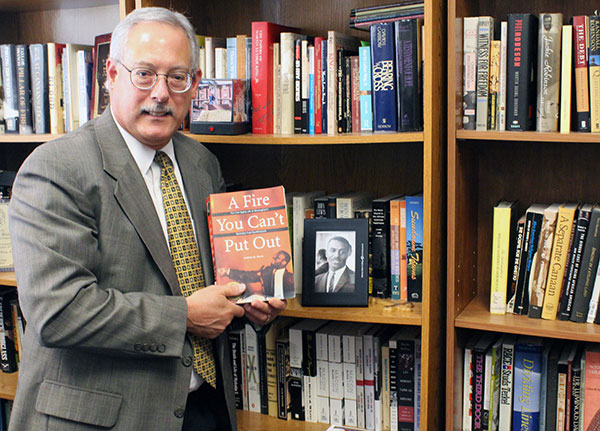MGA Professor Turns His Biography of Civil Rights Icon Into Screenplay
Author: Kelsei Etchison
Posted: Monday, September 25, 2017 12:00 AM
Category:
Pressroom
Macon, GA

Dr. Andrew Manis with a copy of his biography of the Rev. Fred Shuttlesworth. Photo by Kelsei Etchison.
One of Dr. Andrew Manis’s first published books was the historical biography titled “A Fire You Can’t Put Out: The Civil Rights Life of Birmingham’s Reverend Fred Shuttlesworth.”
Since the beginning of the book’s research in 1986, Manis, a History professor at Middle Georgia State University, has also been trying to get Shuttlesworth's story on the big screen.
“Shuttlesworth was fearlessly committed to challenging every aspect of segregation,” Manis said. “There must be some venue in Hollywood that would be willing to bring this story to the attention of America.”
To that end, Manis has adapted his book into a screenplay with the later help of Denise A. Snaer, a screenwriter living in Los Angeles. They recently entered the screenplay into the prestigious Austin (Texas) Film Festival, where it advanced to the second round, a distinction attained by less than 20 percent of this year’s applicants. An estimated total of 9,500 scripts were submitted.
Shuttlesworth was a central leader during the height of the Civil Rights movement in Birmingham, Ala. He founded an organization called the Alabama Christian Movement for Human Rights in an effort to end segregation. He called for the hiring of African-American police officers and bus desegregation. Shuttlesworth helped orchestrate the Birmingham demonstrations of 1963.
Shuttlesworth was not as well-known as some other Civil Right leaders because he chose to stay local and focus on Birmingham, which is also Manis’s hometown. Manis's book focuses on the period before the Birmingham demonstrations of 1963 and what led up to those events.
Manis and Snaer have been working on turning the biography into a feature film or miniseries script since the book’s publication. The life of Shuttlesworth held an abundance of rich historical content, which Manis said made it a challenge to decide what to include and what to leave out of the screenplay.
“To take a 444-page book and reduce it down to a 128-page screenplay was a lengthy process,” Manis said. “Logically, everything could not be included.”
Once the Manis/Snaer screenplay was completed, it was submitted to not only the Austin festival but to the PAGE International Screenwriting Awards, which were according to the website, “established to give new screenwriters the opportunity to get their scripts into the hands of top industry professionals.”
Because the screenplay made it to the second round, Manis had an opportunity to be included in the events at the Austin festival.
Manis is now in the process of granting the film rights to two new producers whom he is confident will be able to move the project from development into production as a miniseries instead of a feature film.
“A two-hour movie will not do this story justice,” he said.
